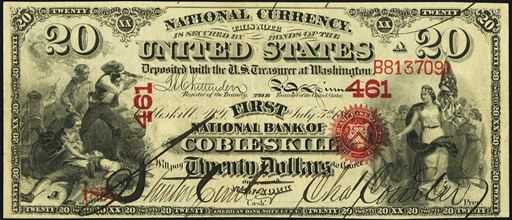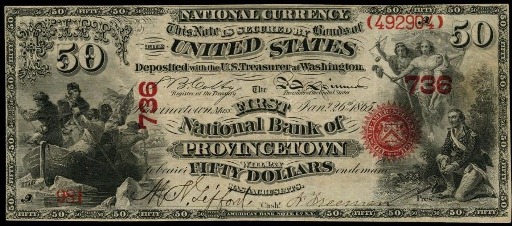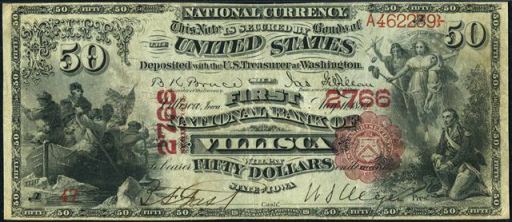The National Bank Of Boyertown
The National Bank Of Boyertown in Pennsylvania printed $2,589,880 dollars worth of national currency. Over $1,000,000 face value is a lot of money. However, some types and denominations of currency from this bank could still be rare. This national bank opened in 1874 and stopped printing money in 1935, which equals a 62 year printing period. That is considering a long operation period for a national bank. During its life, The National Bank Of Boyertown issued 14 different types and denominations of national currency. We have examples of the types listed below. Your bank note should look similar. Just the bank name will be different. For the record, The National Bank Of Boyertown was located in Berks County. It was assigned charter number 2137.
We buy all national currency. Please call or email us for a quote. Sales@AntiqueMoney.com
The National Bank Of Boyertown in Pennsylvania issued 2,125 sheets of $5 original series national bank notes. A print range between 1,000 and 2,500 is small. Combine that with something that was printed before 1875 and you can imagine that these notes are few and far between. Each five dollar original series bank note has a spiked red seal. That is pretty much the only design difference between it and later issues. These are really beautiful notes. One neat thing about these is that the back of each note has a vignette of the corresponding state seal. Some of the state seals are very imaginative. Collecting by state seal was very popular early on in the hobby. Today most collectors are more concerned about bank of issue and condition. Serial number one bank notes are also extremely popular.
Original Series $5 National Bank Note
The National Bank Of Boyertown printed 205 sheets of $20 original series national bank notes. That issue number may or may not sound like a lot of sheets depending on your experience with collectible currency. However, all original series $20 bills are rare. The production amount is irrelevant when it comes to values. These seem like common issues until you want to buy one. These just aren’t readily available from rare banks in very fine or better condition. We definitely feel like these are undervalued in today’s market.
Original Series $20 National Bank Note
The National Bank Of Boyertown also printed 205 sheets of $50 original series national bank notes. The printing number for original series $50 bills is irrelevant. There are only about 35 known to exist from all banks in the country. Despite being extremely rare, condition is still very important. Lots of first charter fifty dollar bills are heavily circulated; there are significant premiums for anything that grades extremely fine or higher.
Original Series $50 National Bank Note
The National Bank Of Boyertown also printed 7,907 sheets of $5 series of 1875 national bank notes. A print range between 5,000 and 10,000 is a pretty high number. But you have to remember we are talking about bank notes from the 1870s and 1880s. Even banks with high issue numbers could be rare today. Series of 1875 $5 bills are some of the most commonly encountered bank notes from the first charter series. Only the original series $1 bill is more available. Some banks exclusively issued five dollar bills. So if you want an example from one of those banks then you don’t have many options. These notes have a rounded red seal and red serial numbers. They also all have a red charter number.
Series of 1875 $5 National Bank Note
The National Bank Of Boyertown also printed 1,750 sheets of $20 series of 1875 national bank notes. The exact number of series of 1875 $20 national bank notes printed by this bank is good to know. Don’t expect a high number to lower the value or a small number to increase the value. These notes are scarce enough on their own that the stats don’t really matter. Twenty dollars was a lot of money between 1875 and 1901, which is the time period in which these were printed. These just weren’t saved in high numbers.
Series of 1875 $20 National Bank Note
The National Bank Of Boyertown also printed 1,750 sheets of $50 series of 1875 national bank notes. The printing number for original series $50 bills is irrelevant. There are only about 35 known to exist from all banks in the country. To make matters worse, these are not being discovered much at all these days. The supply is pretty constant, as is the demand. Prices start at about $10,000 and can go up sharply from there.
Series of 1875 $50 National Bank Note
The National Bank Of Boyertown also printed 11,200 sheets of $10 1882 brown back national bank notes. When we start talking about a printing number in the five figure range, then you are likely not dealing with a great rarity. However, the note could certainly still be popular and valuable. There were three $10 bills printed on a single sheet of 1882 brown backs. The design of the bill is similar to all earlier ten dollar national bank notes. The nickname comes from the fact that these bills have a brown seal and brown overprint. Despite saying series of 1882, these were actually printed by some banks up until 1908. The date you see in cursive relates to when the bank first started issuing brown back notes.
Series of 1882 $10 Brown Back
The National Bank Of Boyertown also printed 11,200 sheets of $20 1882 brown back national bank notes. Due to the way brown back sheets were printed we know that the sheet output number equals the number of $20 brown backs printed. When we see a number over 10,000 there is a good chance that the note isn’t going to be especially rare. However, it never hurts to ask. One neat thing about all brown backs is that they each have a different back design based on which state issued them. The back left hand side of the note shows the state seal of which ever state the national bank was located in. Generally speaking, 1882 $20 brown backs are pretty difficult to locate. They typically were printed in small numbers and they don’t have a great survival rate.
Series of 1882 $20 Brown Back
The National Bank Of Boyertown also printed 5,430 sheets of $10 1882 blue seal national bank notes. That is a pretty standard sheet output number for these issues. Most of the value is going to be in the condition. All of these notes say series of 1882 but they were actually printed between 1908 and 1921. So they aren’t quite as old as the dates might suggest. There is also a date on these notes that is between 1888 and 1901. That date is written in cursive text and it represents when the bank was chartered or re-chartered. Some of the so called 1882 value back notes have a chance to be really rare. Most of the earlier notes that say 1882-1908 on the back are likely going to be relatively common. The designs are exactly the same on the front. Each has a blue seal and charter number.
1882 Blue Seal $10 National Bank Note
The National Bank Of Boyertown also printed 5,430 sheets of $20 1882 blue seal national bank notes. That is the same number of sheets as the ten dollar denomination. You don’t have to multiply by three to get the exact number of notes issued though. There was only one twenty dollar bill per sheet. As with any national bank note, the exact value is still based on the condition, serial number, and bank of issue.
1882 Blue Seal $20 National Bank Note
The National Bank Of Boyertown also printed 19,323 sheets of $10 1902 blue seal national bank notes. Once a bank prints more than 10,000 sheets of blue seals it becomes very difficult for those notes to be rare. 1902 $10 blue seal bank notes all have a portrait of William McKinley on them. Values can range from as little as $40 up to over $10,000. There really is no trick to know what is rare and what is common by just doing an internet search. You really need to work with an expert (like us) in order to determine the value of your specific bank note. There are at least ten different factors than can make some 1902 $10 blue seals worth more than others. We know exactly what to look for and we would be happy to provide a free appraisal and our best offer.
1902 $10 Blue Seal National Bank Note
The National Bank Of Boyertown also printed 19,323 sheets of $20 1902 blue seal national bank notes. The same rarity rules for 1902 $10 blue seals also apply to $20 blue seals. Just remember that $20 bills are by nature three times rarer (unfortunately they don’t command a premium over other denominations). Hugh McCulloch is pictured on the front of each bill. Contact us if you need pricing help.
1902 $20 Blue Seal National Bank Note
The National Bank Of Boyertown also printed 1,204 sheets of Type1 1929 $10 national bank notes. That is a pretty typical sheet output for a national bank during the small size era. Each $10 bill from 1929 has a portrait of Alexander Hamilton on it. The black number written vertically is the charter number. The charter number never affects the value; it is just an identifier. The ten dollar type1 national bank note happens to be the single most common national bank note, with over 65,000 known to exist from all banks. Of course each note is valued based on its condition and rarity. Some are very rare.
Series of 1929 Type1 $10 National Bank Note
The National Bank Of Boyertown also printed 384 sheets of Type1 1929 $20 national bank notes. That may sound like a very small number, and it is. However, when it comes to small size notes, that print range usually allows for a handful of survivors. Andrew Jackson is featured on the front of each 1929 $20 bill. Be sure to take note of the serial number on your specific bank note. If it is 000001 then you can expect a nice premium. There is a special market for serial number one bank notes. Of course, even if the number isn’t #1, it could still be collectible and have a high value just based on its condition and rarity alone.
Series of 1929 Type1 $20 National Bank Note



